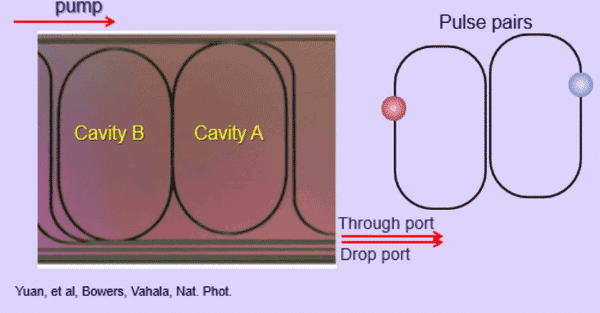Three years back, Caltech's Kerry Vahala and team unveiled a groundbreaking optical innovation known as the turnkey frequency microcomb. This device showcased versatile applications spanning digital communications, precision timekeeping, spectroscopy, and the realms of astronomy.
 In this animated gif, optical pulses (solitons) can be seen circling through conjoined optical tracks. Credit: Yuan, Bowers, Vahala, et al.
In this animated gif, optical pulses (solitons) can be seen circling through conjoined optical tracks. Credit: Yuan, Bowers, Vahala, et al.
This gadget, which is built on a silicon wafer, takes one frequency of laser light as input and transforms it into a train of pulses that can last as little as 100 femtoseconds (quadrillionths of a second), by spacing out the many separate frequencies evenly. (The word “comb” refers to the frequencies’ spacing, which resembles a hair comb’s teeth).
Now, in collaboration with members of his research group and the group of John Bowers at UC Santa Barbara, Vahala (BS ‘80, MS ‘81, PhD ‘85), Caltech’s Ted and Ginger Jenkins Professor of Information Science and Technology and Applied Physics and executive officer for applied physics and materials science, has made a significant advancement in the formation of short pulses in an important new material called ultra-low-loss silicon nitride (ULL nitride), a compound made of silicon and nitrogen.
Silicon nitride undergoes meticulous purification procedures to attain an exceptionally high level of purity before being deposited as a thin film.
This material might theoretically be used to create short-pulse microcomb devices with very low power requirements. Unfortunately, dispersion - a feature that causes light or other electromagnetic waves to travel at varying rates depending on their frequency - prevents this material from correctly generating short light pulses, also known as solitons. Because of ULL’s so-called normal dispersion, ULL nitride waveguides are unable to sustain the brief pulses required for microcomb operation.
The novel microcomb that the researchers developed overcomes the intrinsic optical limits of ULL nitride by producing pulses in pairs, as described in an article published in Nature Photonics.
Since ULL nitride is produced using the same process as computer chips, this is a huge development. As a result of this type of manufacturing process, these microcombs may eventually be included in a large range of portable gadgets that resemble smartphones in shape.
The most characteristic feature of a typical microcomb is a tiny optical loop that resembles a little racetrack. The solitons spontaneously form and move around it while it is in operation.
However, when this loop is made of ULL nitride, the dispersion destabilizes the soliton pulses.
Zhiquan Yuan, Study Co-Author and Graduate Student, T. J. Watson Laboratory of Applied Physics, California Institute of Technology
Think of the loop as an automobile racetrack. Instead of remaining in a close group as they circle the circuit, the vehicles will spread apart if some move more quickly than others. Similarly, when ULL disperses normally, light pulses disperse across the microcomb’s waveguides, rendering the device inoperable.
The group came up with the idea to build several racetracks and pair them together so they resembled a figure eight. The two tracks are almost exactly parallel to one another in the middle of that eight.
Extending the racetrack analogy, imagine two tracks converging onto a single straight stretch. As cars from each track merge onto this shared section, a scenario akin to a traffic jam unfolds. Similar to the slowdown caused by two lanes merging into one on a freeway, the confluence of the two microcombs creates a situation where the paired laser pulses bunch up.
This bunching effect acts against the pulses' natural tendency to disperse, effectively counteracting it and enabling the microcombs to function optimally.
In effect, this counteracts the normal dispersion and gives the overall composite system the equivalent of anomalous dispersion.
Maodong Gao, Study Co-Author and Graduate Student, T. J. Watson Laboratory of Applied Physics, California Institute of Technology
The concept grows with the addition of additional racetracks, and the team has demonstrated how three racetracks will function by generating two sets of pulse pairs. According to Vahala, the phenomena will persist even in the case of numerous connected racetracks, or microcombs, providing a means of constructing sizable photonic circuit arrays for the soliton pulses.
As previously mentioned, the same machinery used to create computer circuits based on complementary metal-oxide-semiconductor (CMOS) technology is also utilized to build these ULL microcombs.
The manufacturing scalability of the CMOS process means that it will now be easier and more economical to manufacture the short-pulse microcombs and integrate them into existing technologies and applications.
John Bowers, Study Co-Author and Professor, ECE Department, University of California Santa Barbara
Concerning these applications, Vahala says “A comb is like a Swiss army knife for optics. It has many different functions, and that's why it's such a powerful tool.”
Besides Vahala, Yuan, and Gao, the research team includes co-authors such as applied physics graduate student Yan Yu; Heming Wang, previously affiliated with Caltech and currently at Stanford University; Warren Jin from UC Santa Barbara and Anello Photonics; Qing-Xin Ji; along with Avi Feshali and Mario Paniccia from Anello Photonics.
Financial support for this research endeavor was provided by the Defense Advanced Research Projects Agency, the Defense Threat Reduction Agency's Joint Science and Technology Office for Chemical and Biological Defense, and the Air Force Office of Scientific Research.
Journal Reference:
Yuan, Z., et al. (2023). Soliton pulse pairs at multiple colors in normal dispersion microresonators. Nature Photonics. doi/s41566-023-01257-2